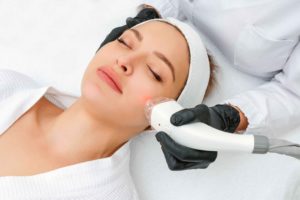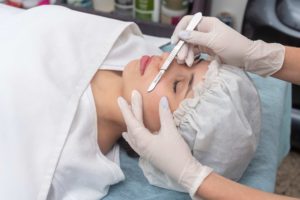Introduction

Dermaplaning has become a popular beauty treatment in recent years, with many people turning to this exfoliation technique to achieve smoother, brighter, and healthier-looking skin. This non-invasive procedure involves using a surgical blade to remove dead skin cells and fine facial hair, revealing a smoother and more radiant complexion. While dermaplaning offers several benefits, there are also potential risks you should be aware of before deciding to undergo this treatment. In this blog post, we will guide you through the benefits, risks, and aftercare of dermaplaning, so you can decide whether this treatment is right for you. Whether you’re new to dermaplaning or considering trying it again, keep reading to learn everything you need about this popular skincare treatment.
Benefits of Dermaplaning
Dermaplaning is a beneficial treatment for many individuals, as it can address several skin concerns and provide a variety of benefits. Below are some of the main benefits of dermaplaning:
Exfoliation: Dermaplaning provides deep exfoliation, removing dead skin cells and other debris that can clog pores and cause dullness.
Smoother Skin Texture: Removing dead skin cells can help improve the texture and tone of the skin, resulting in a smoother and more even complexion.
Removal of Peach Fuzz: Dermaplaning is also known for removing fine facial hair, also known as “peach fuzz.” This can create a smoother surface for makeup application and allow for better product penetration.
Enhance Product Penetration: By removing dead skin cells, products can penetrate deeper into the skin, increasing their efficacy.
Skin Brightening: Dermaplaning can help to reduce the appearance of dark spots and hyperpigmentation, resulting in a brighter and more radiant complexion.
Dermaplaning can benefit those looking to improve their skin’s texture, tone, and overall appearance. However, weighing these benefits against the potential risks is important before deciding if dermaplaning is right for you.
Risks of Dermaplaning
While dermaplaning is generally considered safe, you should be aware of some risks associated with this procedure. Below are some of the potential risks of dermaplaning:
Skin Irritation: Some individuals may experience skin irritation following dermaplaning, such as redness or itching.
Acne Breakouts: Dermaplaning can cause acne breakouts, as it can stimulate oil production in the skin.
Sensitivity: Individuals with sensitive skin may experience discomfort or irritation during the procedure.
Scarring: In rare cases, dermaplaning can cause scarring or other skin damage.
Hyperpigmentation: Dermaplaning can cause hyperpigmentation in individuals with darker skin tones.
It’s important to note that these risks are rare and can be minimized by ensuring you receive treatment from a qualified and experienced professional. Before dermaplaning, discuss your skin concerns and potential risks with your skincare provider.
Which Areas Are Treated and How Long Do Results Last?
Dermaplaning is a facial treatment that can be used to treat a variety of skin concerns. At Beauty Nurse Bre, dermaplaning is used to improve wrinkles, age spots, and acne scars on the face, beneath the chin, and the sides of the neck. By removing dead skin cells and fine facial hair, dermaplaning can leave your skin looking smoother, brighter, and more youthful.
One common question about dermaplaning is how long the results last. The skin improvements you get from the procedure can last up to three weeks. However, it’s important to note that individual results may vary. For optimal results, we recommend scheduling follow-up procedures every 4-6 weeks to preserve the effects of the treatment.
Another frequently asked question is when patients will see results after their dermaplaning treatment. Your skin will appear softer immediately after the procedure, and you may notice some subtle improvements in your skin’s texture and tone. However, it can take five to seven days to see the full results of the treatment. Again, individual results may vary, so following your skincare provider’s aftercare instructions and scheduling any recommended follow-up appointments is essential.
Before Dermaplaning
Before undergoing dermaplaning, you should do a few things to prepare for the procedure. Below are some of the steps you should take before your appointment:
Consultation: Before scheduling your dermaplaning appointment, you should schedule a consultation with your skincare provider. During this consultation, you can discuss your skin concerns, medications, and other factors affecting your ability to undergo the procedure.
Precautions: You should avoid specific skincare treatments before your dermaplaning appointments, such as chemical peels or exfoliating scrubs, as they can make your skin more sensitive.
How to Prepare: On the day of your appointment, you should arrive with clean, makeup-free skin. Avoid applying products to your skin before the procedure, as they can interfere with the treatment.
By taking these steps before your dermaplaning appointment, you can ensure that your skin is prepared for the procedure and that you can achieve the best possible results.
After Dermaplaning
After your dermaplaning treatment, there are several things you should do to ensure that your skin heals properly and that you achieve the best possible results. Below are some of the steps you should take after your dermaplaning appointment:
Sun Protection: You should avoid direct sun exposure for at least a week following your treatment, as your skin will be more sensitive to the sun’s harmful rays. If you go outside, apply a broad-spectrum sunscreen with an SPF of at least 30.
Gentle Skincare: Avoid using harsh or abrasive skincare products, such as exfoliating scrubs or retinol creams for the first few days after your treatment. Instead, select gentle, non-irritating products to help soothe and hydrate your skin.
Avoid Makeup: While applying makeup following your treatment may be tempting, it’s best to avoid it for at least 24 hours. This will give your skin time to heal and reduce the risk of irritation or infection.
Follow-up Appointments: Depending on your skincare goals, your provider may recommend follow-up dermaplaning treatments to maintain your results. Discuss your options with your provider to determine the best course of action for your skin.
Final Thoughts
In conclusion, dermaplaning is a highly effective and safe treatment for achieving smoother, brighter, and more radiant skin. If you’re interested in trying dermaplaning, Beauty Nurse Bre is a top-tier provider to consider. They constantly advance their dermaplaning techniques and use a scalpel to gently exfoliate dull cells and peach fuzz, resulting in soft skin. The treatment typically takes 15-30 minutes, and before beginning the procedure, your skin will be cleansed and dried.
At Beauty Nurse Bre, you can relax as their team of licensed and experienced skincare professionals performs the dermaplaning treatment, facilitating cell renewal for noticeable improvements. You’ll see the benefits of the treatment as you seamlessly apply makeup and enjoy more profound absorption from serums. Once your skin is treated, they will coat the area with a nourishing moisturizer to seal in hydration and enhance the results.
In addition to dermaplaning, Beauty Nurse Bre offers a range of other skincare services, including Botox, fillers, chemical peels, and more. They are committed to providing personalized, safe, and effective care to help you achieve your unique skincare goals.
To schedule a consultation with Beauty Nurse Bre and learn more about their dermaplaning and other skincare services, don’t hesitate to contact them today. With their advanced techniques and comprehensive aftercare, you can trust that you’ll achieve the best possible results with Beauty Nurse Bre.





